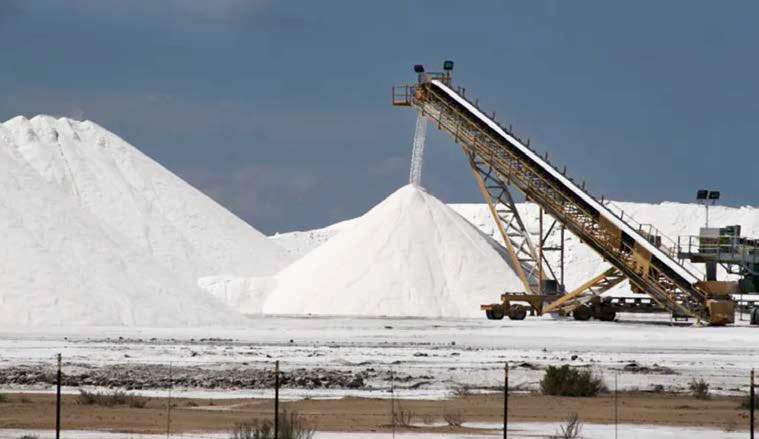Brice Wallace
Farmers and mineral extractors have a role to play in keeping the Great Salt Lake from shrinking, according to a group that has studied the lake.
The Great Salt Lake Strike Team — consisting of state agency professionals and experts in public policy, hydrology, water management, climatology, and dust — unveiled a report last week containing six recommendations for gubernatorial and legislative support in the coming year.{mprestriction ids="1,3"}
“The Strike Team stands ready to support state leaders in this important work,” it said. “This policy assessment provides a first step. As responsible stewards, we have many more steps to take.”
Among the recommendations are setting a lake elevation range goal, investing in conservation, investing in water monitoring and modeling, developing a holistic water management plan, and requesting an in-depth analysis of policy options.
According to the Utah Division of Wildlife Resources, average annual lake level hit a record low of 4,190.1 feet elevation last summer. It dipped to 4,188.6 feet in late October, a daily record low. For comparison, it reached a peak of 4,210.4 feet in 1987.
The Strike Team recommends policymakers adopt a lake elevation target level range based on analysis prepared by the Utah Division of Forestry, Fire and State Lands of between 4,198 to 4,205 feet.
“Declining water levels of Great Salt Lake threaten economic activity, local public health and ecosystems,” the assessment said. “The situation requires urgent action. Fortunately, science provides crucial perspective, understanding and scenarios for policymakers to chart a path forward. Many policy levers can help return the lake to healthy levels.”
Among the team’s policy options regarding conservation are the optimized use of agricultural water and optimizing lake mineral extraction.
The assessment indicates that a few million tons of dissolved salts and minerals flow from the Jordan, Weber and Bear rivers into the lake each year. The lake’s economic output is $1.32 billion annually, with a total labor income of $375.1 million and total employment of 7,706 jobs. Among the industries on the lake are those collecting magnesium, sulfate of potash and brine shrimp. Compass Minerals wants to begin lithium carbonate extraction in 2025.
Mining companies, the assessment said, extract nearly 2 million tons of minerals per year from the lake, primarily through evaporation at diked ponds. A state report in 2021 said the mineral extraction industry at the lake “makes close to $300 million per year.”
“There are over 85,000 acres of diked evaporation ponds in Great Salt Lake, comprising an area twice that of San Francisco,” the Strike Team assessment said.
Among the mineral extraction companies are Cargill, Compass Minerals, Morton and U.S. Magnesium.
Extractors hold a total of over 600,000 acre-feet of water rights and in 2020 depleted a total of 182,000 acre-feet of water, according to the study.
“The state is currently working with these companies to encourage innovative processes for new mineral development. … These companies rely upon the evaporation of lake brines in their extractive processes. However, brines have become harder to reach due to low water levels. The Utah Division of Forestry, Fire and State Lands (FFSL) is currently working with industry to encourage technologies that are not reliant on evaporation and those that reduce water depletions.”
The Strike Team assessment indicates policy options have tradeoffs.
“Eliminating mineral production on GSL has economic consequences and threatens a key source of three of the state’s critical minerals,” it said. “However, Great Salt Lake cannot sustain continued water diversions and depletions at the rate seen in previous decades. The state is encouraging innovation and sustainability in the development of lithium on the lake.”
Reducing agriculture usage of water from inflow rivers by 10 percent to 15 percent could be achieved through on-farm optimization without reducing production, according to the assessment. Such optimization would make farming more resilient to drought and could supply nearly 180,000 acre-feet of water annually to the lake without reducing crop production.
Among the optimization measures are improving conveyance systems that deliver water to the farm, and a variety of on-farm improvements in water, crop and soil management. “Greater reductions in depletion are possible but would require compensated strategic deficit irrigation or fallowing,” it said. “This optimization comes at various costs ranging from about $60-400 per acre-feet of water per year, based on which practices are implemented.”
Among risks are lost agriculture production and profit, high ongoing costs of on-farm optimization or fallowing, and damages to rural communities and industries that rely on agriculture.
“Reducing agriculture water depletion is difficult without reducing crop production,” the assessment said. “Most water used in agriculture is ‘beneficially used’ through crop consumption or returns to natural systems. Agricultural optimization requires capital-intensive changes that often exceed producers’ capacity to perform without assistance.”
The Kem C. Gardner Policy Institute conducted a Newsmaker Breakfast event last week to discuss the assessment and policy options. The gathering took place after press deadlines for The Enterprise.{/mprestriction}








